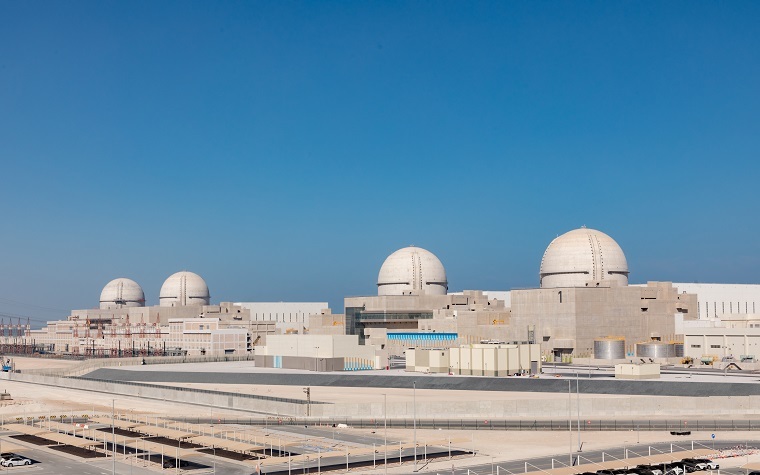Khalifa University recently issued the following announcement.
With electricity demand in the GCC growing, the region is turning to nuclear to diversify its power mix and reduce reliance on fossil fuels. The UAE understands that nuclear power can be one major component of the decarbonizing process: A new UAE energy plan announced in January 2017 involves investment of USD163 billion by 2050 to achieve half of its energy from nuclear power and renewables.
At Khalifa University, we’re poised to join the drive towards nuclear power in the UAE. Our Department of Nuclear Engineering is innovating in nuclear engineering research and education to produce graduates who will be able to substantially contribute to academia, industry, and the community.
The need for diversification of energy resources, consistent with international attention to climate change, makes nuclear energy seem newly attractive and attention is turning to the completion of the first nuclear unit at the new Abu Dhabi Barakah Nuclear Energy Plant.
In 2016, the UAE produced 130 TWh of electricity, almost exclusively from fossil fuels. Concurrently, the country relies entirely on electricity generation to provide its power as well as much of its potable water from thermal desalination via cogeneration with electricity. The four nuclear units at Barakah are expected to produce up to 25 percent of the UAE’s electricity at an affordable cost and further support the UAE’s transition to emissions free electricity based desalination technologies.
To support the long-term sustainability of the UAE Peaceful Nuclear Energy Program, the Emirates Nuclear Technology Center was inaugurated by the UAE Minister of Energy and Industry at Khalifa University’s Sas Al Nakhl Campus in November 2019 as a dedicated innovation hub for peaceful nuclear technologies.
Nuclear energy is a mature industry with a record of safety and reliability without the emission of greenhouse gases, and is economically attractive for power generation once all capital investments have been made. The interest in nuclear power for meeting future electricity and seawater desalination needs in the GCC states is prudent, logical and timely given the availability of financing and strong commitment to safe and efficient operation.
Admittedly, nuclear power plants generally have higher up front costs to build and a larger investment than an equivalent coal- or gas-fueled plant, but they provide electricity at a lower marginal cost, combined with fewer greenhouse gas emissions and a tremendously long life expectancy that can extend well beyond that of a conventional fossil fuel plant.
One of the key challenges is integrating nuclear units into the electricity network and optimizing the system to ensure security of supply for all power needs, including water production via reverse osmosis.
Nuclear energy plants generally tend to generate electricity only, whereas the GCC is accustomed to co-generation where power plants generate electricity and also desalinated water. Unless the system adopts nuclear technology which directly integrates desalination technology, then the challenge remains in terms of ensuring sufficient capacity for growing desalination needs. However, future desalination plants in the region are largely focused on using reverse osmosis, making nuclear energy an adequate power generation solution.
The Emirates Nuclear Technology Center (ENTC), for which I serve as the Director, will focus on three areas initially: nuclear safety and systems, nuclear materials science and chemistry, and radiation safety in the environment. The ENTC will cement the UAE’s position as an international role model for the development of new peaceful nuclear technology projects around the world. Innovation and continuous development are essential to the sustainability and long-term success of the UAE’s requirements for nuclear technology research in various sectors, as well as the UAE’s ongoing transition to a knowledge-based economy and society.
We also have a scaled-down model of one of the four advanced pressurized water nuclear reactor (APR-1400) units constructed at Barakah on display at Khalifa University’s main campus to provide students and visitors an in-depth insight to the basics of a nuclear energy plant’s operations.
The pressurized water reactor (PWR) is the most common reactor used in the world’s nuclear power plants. The core inside the reactor vessel creates heat, while the pressurized water in the primary coolant loop carries this heat to the steam generator. The ‘steam-line’ directs the steam to the main turbine, turning the generator and producing electricity.
The Emirates Nuclear Technology Center will engage in research projects designed and approved by the ENTC’s Senior Management Board, conducted by students, academics and researchers from Khalifa University. Research is already underway in nuclear materials science, reactor design and analysis, instrumentation and control, environmental and waste management, and nuclear safeguards and security. Our research is supporting the UAE’s nuclear technology programs to meet the country’s future nuclear technology needs in many sectors from energy to health, and from forensics to security.
The Barakah Nuclear Energy Plant is now more than 93 percent complete. Following receipt of the Operating License for Unit 1 in February 2020, the initial fuel load was completed in March and preparations to generate the first clean, safe, 24/7 electricity from nuclear energy are steadily underway.
Dr. Philip Beeley is Professor and Chair of Nuclear qEngineering and Director of the Emirates Nuclear Energy Center at Khalifa University.
Original source: https://www.ku.ac.ae/how-nuclear-will-help-meet-regions-growing-energy-demands-sustainably/




 Alerts Sign-up
Alerts Sign-up